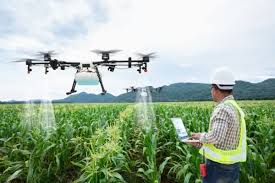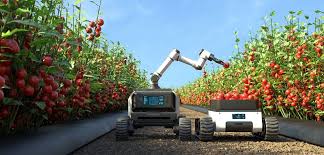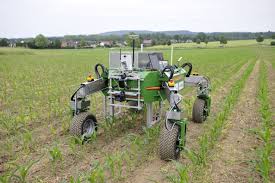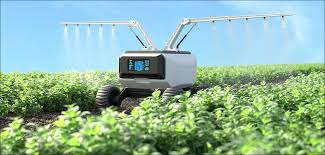In 2022, the global market size of agricultural robotics was nearly $5billion. The need to meet the increasing global food demand is one of the major driving forces for the wide application and adoption of agriculture robotics.
Many farming activities performed by humans can now be done by agricultural robots (agribots), maximizing productivity and saving enormous resources. Today, agribots are used in seed planting, crop harvesting, weeding, sorting and packaging, livestock management, etc.
History of Agricultural Robotics
The evolution of agricultural robotics can be traced through several key milestones:
1. Early Developments (1940s-1980s): The first significant advances in agricultural technology began in the mid-20th century. Early mechanization involved simple machines like tractors and plows, which paved the way for more complex systems.
2. Introduction of Automated Machinery (1980s-2000s): By the 1980s, advancements in electronics and computing technology led to the development of automated machinery for specific tasks, such as seed planting and irrigation systems. These machines laid the groundwork for more sophisticated robotics.
3. Emergence of Robotics (2000s-Present): The 21st century saw the rise of advanced robotics in agriculture, driven by innovations in artificial intelligence (AI), machine learning, and sensors. Researchers and companies began developing robots capable of performing tasks like weeding, harvesting, and monitoring crop health.
4. Current Trends: Today, agricultural robotics continues to evolve, with a focus on precision farming. Robots are being integrated with data analytics and IoT technology, allowing farmers to optimize yields, reduce resource use, and increase efficiency.
Types of Agricultural Robots

Agricultural robots come in various forms, each designed for specific tasks:
1. Autonomous Tractors: These self-driving tractors can perform plowing, planting, and tilling without human intervention, increasing efficiency and reducing labor costs.
2. Harvesting Robots: These robots are designed to pick fruits and vegetables. They use computer vision and AI to identify ripe produce and harvest it carefully, minimizing damage.
3. Weeding Robots: These robots can identify and remove weeds using mechanical or chemical methods. They help reduce the reliance on herbicides, promoting sustainable farming practices.
4. Planting Robots: Designed to automate the planting process, these robots can sow seeds at optimal depths and spacing, ensuring better crop establishment.
5. Monitoring and Surveying Drones: Drones equipped with cameras and sensors can survey fields, capturing data on crop health, moisture levels, and nutrient status. They provide valuable insights for farmers.
6. Livestock Robots: These robots are used in animal husbandry for tasks like feeding, milking, and monitoring animal health, improving efficiency and animal welfare.
Benefits of Agricultural Robotics
The integration of robotics in agriculture offers numerous advantages:
1. Increased Efficiency: Robots can operate continuously without fatigue, performing tasks faster and more consistently than human laborers, which enhances productivity.
2. Labor Cost Reduction: By automating repetitive and labor-intensive tasks, farmers can reduce labor costs and address the labor shortage in the agricultural sector.
3. Precision Farming: Robotics enables farmers to carry out precise applications of inputs like water, fertilizers, and pesticides, reducing waste and minimizing environmental impact.
4. Improved Crop Management: Robots equipped with sensors can monitor crop health in real-time, providing data that helps farmers make informed decisions about irrigation, fertilization, and pest control.
5. Enhanced Safety: Robots can perform dangerous tasks, such as operating heavy machinery or handling chemicals, reducing the risk of accidents and injuries for farmworkers.
Read Also: 11 Medicinal Health Benefits of Barbarea vulgaris (Yellow Rocket)
Challenges in Agricultural Robotics

Despite the benefits, there are challenges to adopting agricultural robotics:
1. High Initial Costs: The investment required for robotic systems can be significant, making it challenging for small-scale farmers to adopt these technologies.
2. Technical Complexity: Agricultural robots require advanced technology and expertise to operate and maintain, which may be a barrier for some farmers.
3. Integration with Existing Systems: Incorporating robotics into traditional farming practices may require changes to existing processes, which can be difficult for some farms.
4. Weather Dependence: Many agricultural robots rely on external conditions, such as soil moisture and weather patterns, which can affect their efficiency and effectiveness.
5. Data Privacy and Security: The use of sensors and connected devices raises concerns about data privacy and the security of agricultural information.
Applications of Agricultural Robotics in Crop Management
Agricultural robots play a vital role in various aspects of crop management:
1. Crop Monitoring: Drones and ground-based robots can continuously monitor crops for signs of stress, disease, or pest infestations. This real-time data helps farmers respond quickly to issues.
2. Precision Irrigation: Robots equipped with soil moisture sensors can automate irrigation systems, ensuring that crops receive the right amount of water while conserving resources.
3. Automated Harvesting: Harvesting robots can identify and pick ripe crops, reducing labor costs and minimizing waste. This application is particularly valuable for labor-intensive crops like berries and tomatoes.
4. Soil Health Management: Robots can analyze soil health by measuring nutrient levels and compaction. This information allows farmers to adjust their management practices accordingly.
5. Weed Management: Weeding robots can identify and remove weeds with precision, reducing the need for chemical herbicides and promoting sustainable practices.
6. Data Analysis and Decision Support: Agricultural robots collect vast amounts of data that can be analyzed to provide insights into crop performance, helping farmers make informed decisions to optimize yields.
Applications of Agricultural Robotics in Livestock Management
Agricultural robotics has transformed livestock management through various innovative applications:
1. Automated Feeding Systems: Robots can be programmed to deliver feed to livestock at scheduled times, ensuring that animals receive consistent nutrition. This not only improves feeding efficiency but also reduces waste.
2. Milking Robots: Robotic milking systems allow cows to be milked automatically, increasing productivity and reducing labor costs. These systems can also monitor the health of each cow, providing valuable data on milk production and animal health.
3. Health Monitoring: Wearable sensors and monitoring systems can track vital signs, activity levels, and behavior patterns of livestock. This data helps farmers detect health issues early, enabling timely interventions.
4. Automated Sorting and Handling: Robotics can assist in sorting livestock for breeding, milking, or veterinary care. This reduces stress on the animals and improves operational efficiency.
5. Environmental Control: Robots can help manage barn conditions by monitoring temperature, humidity, and ventilation, ensuring a comfortable environment for livestock and enhancing overall animal welfare.
6. Precision Breeding: Robotics and data analysis can optimize breeding programs by identifying the best candidates for reproduction based on genetic information and performance metrics.
Future Trends in Agricultural Robotics
The future of agricultural robotics is promising, with several trends shaping its development:
1. Increased Autonomy: Future robots are expected to operate with greater autonomy, reducing the need for human intervention. This will allow for continuous monitoring and management of crops and livestock.
2. Enhanced AI Integration: As AI technology advances, robots will become more capable of making real-time decisions based on complex data analysis, leading to improved efficiency and productivity.
3. Collaboration with Drones: The combination of drones and ground-based robots will create a comprehensive monitoring and management system, allowing farmers to oversee large areas efficiently.
4. Data-Driven Decision Making: The use of big data analytics will become more prevalent, enabling farmers to make informed decisions based on insights derived from sensor data and robotic systems.
5. Development of Smaller, Modular Robots: Smaller robots that can work in tandem are likely to emerge, allowing for flexible and scalable solutions for farms of all sizes.
6. Focus on Sustainability: Future agricultural robots will likely prioritize sustainable practices, such as precision application of inputs, reducing resource waste, and minimizing environmental impact.
Read Also: 11 Medicinal Health Benefits of Yellow Water-lily (Nuphar Advena)
Impact of Agricultural Robotics on Labor

The introduction of agricultural robotics has a significant impact on the labor market:
1. Labor Efficiency: Robotics can perform repetitive tasks more efficiently than human laborers, leading to increased productivity on farms. This allows human workers to focus on more complex tasks that require critical thinking and problem-solving skills.
2. Labor Shortages Mitigation: As the agricultural sector faces labor shortages, robotics can fill gaps by automating essential tasks, ensuring that operations continue smoothly.
3. Job Transformation: While some traditional farming jobs may decline, new roles related to robotics operation, maintenance, and data analysis will emerge, requiring workers to adapt and develop new skills.
4. Potential Job Displacement: There is a concern that increased automation may lead to job displacement for certain positions. However, many experts believe that robotics will complement human labor rather than completely replace it.
5. Enhanced Work Conditions: Automation of labor-intensive tasks can reduce physical strain on workers, improving overall job satisfaction and safety in the agricultural workforce.
Integration of AI and Machine Learning in Agricultural Robotics
AI and machine learning play a crucial role in enhancing the capabilities of agricultural robotics:
1. Data Analysis and Insights: Machine learning algorithms can analyze vast amounts of data collected by agricultural robots, providing insights into crop health, livestock behavior, and environmental conditions.
2. Predictive Analytics: AI can be used to predict trends and outcomes based on historical data, helping farmers make proactive decisions regarding planting, harvesting, and livestock management.
3. Computer Vision: AI-powered computer vision systems enable robots to identify plants, detect pests, and assess crop health. This enhances the precision of tasks such as spraying pesticides or harvesting crops.
4. Adaptive Learning: Agricultural robots equipped with machine learning can adapt their behavior based on real-time data, allowing them to improve their performance over time and respond to changing conditions.
5. Automation of Complex Tasks: The integration of AI allows robots to perform complex tasks that require decision-making, such as determining the best time to harvest or identifying the most efficient feeding strategy for livestock.
6. Personalized Farming Solutions: AI-driven insights can lead to tailored recommendations for farmers, optimizing practices for specific crops or livestock based on individual farm conditions.
Do you have any questions, suggestions, or contributions? If so, please feel free to use the comment box below to share your thoughts. We also encourage you to kindly share this information with others who might benefit from it. Since we can’t reach everyone at once, we truly appreciate your help in spreading the word. Thank you so much for your support and for sharing!
Read Also: Air Transportation Pollution: A Comprehensive Guide

